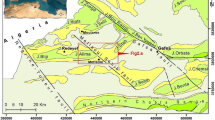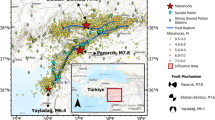Abstract
In the present work, geological and geotechnical studies were carried out to find the causes and mechanisms of a reinforced embankment slope failure. The information collected from the surface investigations combined with the borehole data analysis helped to understand the landslide process, to perform analyses to determine the movement mechanism, and to identify the factors contributing to the landslide. Subsurface features, including the sliding mass, slid surface, stable layer below slid surface, and groundwater, are determined based on borehole logs, from which cores of landslide masses and bedrock have been retrieved and analyzed. Laboratory tests were carried out to estimate the geomechanical properties of soil, sandstone, and mudstone that constitute the slope. Slope stability analyses were carried out to evaluate the effectiveness of the reinforcement system and to analyze the failure mechanism. A discussion is presented on the following aspects: (a) influencing factors and failure mechanism and (b) synergistic effect of rainfall and weak layer. The results show that the rainfall is the main inducing factor of slope instability, while the effect of the groundwater on the weak layer played a vital role in the landslide event. The anti-slide pile structure was found to be damaged, which indicates that further research is required in coming up with better designs and constructions of such structures for high fill slopes with soft foundations. The results also indicated that an effective drainage system should be implemented in improving the stability of the slope.













Similar content being viewed by others
References
Al-Homoud AS, Saket SK, Husein AI (1994) Investigation of failure of highway embankment founded on colluvium and suggested stabilization measures for reconstruction. Eng Geol 38(1-2):95–116
Alonso EE, Pinyol NM (2015) Slope stability in slightly fissured claystones and marls. Landslides 12(4):643–656
Bai S, Wang J, Thiebes B et al (2014) Analysis of the relationship of landslide occurrence with rainfall: a case study of Wudu County, China. Arab J Geosci 7(4):1277–1285
Bourenane H, Bensalem R, Oubaiche EH et al (2022) The large deep-seated landslide induced by the March 12th, 2012 rainfall event in the city of Azazga, Northern Algeria: deformation characteristics and failure mechanisms. Environ Earth Sci 81(19):476
Casagli N, Dapporto S, Ibsen ML et al (2006) Analysis of the landslide triggering mechanism during the storm of 20th–21st November 2000, in Northern Tuscany. Landslides 3(1):13–21
Di Maio C, Vassallo R (2011) Geotechnical characterization of a landslide in a Blue Clay slope. Landslides 8(1):17–32
Grana V, Tommasi P (2014) A deep-seated slow movement controlled by structural setting in marly formations of Central Italy. Landslides 11(2):195–212
Hong Y, Hiura H, Shino K et al (2005) Quantitative assessment on the influence of heavy rainfall on the crystalline schist landslide by monitoring system-case study on Zentoku landslide, Japan. Landslides 2(1):31–41
Hu G, Liu M, Chen N et al (2019) Real-time evacuation and failure mechanism of a giant soil landslide on 19 July 2018 in Yanyuan County, Sichuan Province, China. Landslides 16(6):1177–1187
Huang QX, Xu XT, Kulatilake PHSW et al (2020) Formation mechanism of a rainfall triggered complex landslide in southwest China. J Mt Sci 17(5):1128–1142
Huang X, Wang L, Ye R et al (2022) Study on deformation characteristics and mechanism of reactivated ancient landslides induced by engineering excavation and rainfall in Three Gorges Reservoir area. Nat Hazards 110(3):1621–1647
Husein Malkawi AI, Taqieddin SA (1996) Geotechnical study of landslides resulting from a highway construction in Jordan. Nat Hazards 13(1):1–15
Kamai T, Sangawa A (2011) Landslides on ancient embankments in the Kinki district (Japan): strong motion seismoscope of the 1596 Keichou-Fushimi earthquake. Quat Int 242(1):90–105
Kang GC, Song YS, Kim TH (2009) Behavior and stability of a large-scale cut slope considering reinforcement stages. Landslides 6(3):263–272
Kang X, Xu G, Yu Z et al (2020) Experimental investigation of the interaction between water and shear-zone materials of a bedding landslide in the Three Gorges Reservoir Area, China. Bull Eng Geol Environ 79:4079–4092
Kuo YS, Tsai YJ, Chen YS et al (2013) Movement of deep-seated rainfall-induced landslide at Hsiaolin Village during Typhoon Morakot. Landslides 10(2):191–202
Li Y, Xue K, Zhao Y et al (2023) Study on the stability and disaster mechanism of layered soil slopes under heavy rain. Bull Eng Geol Environ 82(7):272
Liu J, Xu Q, Wang S et al (2020) Formation and chemo-mechanical characteristics of weak clay interlayers between alternative mudstone and sandstone sequence of gently inclined landslides in Nanjiang, SW China. Bull Eng Geol Environ 79:4701–4715
Maduka RI, Igwe O, Ayogu NO et al (2017) Geotechnical assessment of road failure and slope monitoring along Nsukka-Adoru-Idah highway, Southeastern Nigeria. Environ Monit Assess 189(1):1–18
Matsuura S, Asano S, Okamoto T (2008) Relationship between rain and/or meltwater, pore-water pressure and displacement of a reactivated landslide. Eng Geol 101(1-2):49–59
Montrasio L, Valentino R, Losi GL (2011) Towards a real-time susceptibility assessment of rainfall-induced shallow landslides on a regional scale. Nat Hazards Earth Syst Sci 11(7):1927–1947
Peng T, Chen N, Hu G et al (2022) Failure mechanism of Dege landslide in western China, March, 2021: the loess interlayer and multiple water resources. Landslides 19(9):2189–2197
Prountzopoulos G, Fortsakis P, Seferoglou K, Chrysochoidis F, Vassilopoulou I, Perleros V (2014) Assessment of Failure Mechanism and Rehabilitation of a Landslide Within Marly Formations in NW Greece: From the Site Investigation to the Geotechnical Design. Geotechnical and Geological Engineering 32(6):1485–1502. https://doi.org/10.1007/s10706-014-9729-8
Regmi AD, Yoshida K, Nagata H et al (2013) The relationship between geology and rock weathering on the rock instability along Mugling–Narayanghat road corridor, Central Nepal Himalaya. Nat Hazards 66(2):501–532
Ronchetti F, Borgatti L, Cervi F et al (2009) Hydro-mechanical features of landslide reactivation in weak clayey rock masses. Bull Eng Geol Environ 69(2):267–274
Schulz WH, McKenna JP, Kibler JD et al (2009) Relations between hydrology and velocity of a continuously moving landslide—evidence of pore-pressure feedback regulating landslide motion? Landslides 6(3):181–190
Shinoda M, Yoshida I, Watanabe K et al (2022) Seismic probabilistic risk estimation of Japanese railway embankments and risk-based design strength of soil and reinforcement. Soil Dyn Earthq Eng 163:107507
Sun HY, Pan P, Lü Q et al (2019) A case study of a rainfall-induced landslide involving weak interlayer and its treatment using the siphon drainage method. Bull Eng Geol Environ 78:4063–4074
Sun L, Shen F, Li C (2023) Water-induced weakening retrogressive landslides: a study on the progressive failure process and formation mechanism of trailing edge fracture surfaces. Bull Eng Geol Environ 82(6):201
Taga H, Turkmen S, Kacka N (2015) Assessment of stability problems at southern engineered slopes along Mersin-Tarsus Motorway in Turkey. Bull Eng Geol Environ 74(2):379–391
Tandon RS, Gupta V, Venkateshwarlu B (2021) Geological, geotechnical, and GPR investigations along the Mansa Devi hill-bypass (MDHB) Road, Uttarakhand, India. Landslide 18(3):849–863
Vassallo R, Grimaldi GM, Di Maio C (2015) Pore water pressures induced by historical rain series in a clayey landslide: 3D modeling. Landslides 12(4):731–744
Wasowski J (1998) Understanding rainfall-landslide relationships in man-modified environments: a case-history from Caramanico Terme, Italy. Environ Geol 35(2):197–209
Wei Z, Yin G, Wang JG et al (2012) Stability analysis and supporting system design of a high-steep cut soil slope on an ancient landslide during highway construction of Tehran-Chalus. Environ Earth Sci 67(6):1651–1662
Wu CH, Chen SC, Feng ZY (2014) Formation, failure, and consequences of the Xiaolin landslide dam, triggered by extreme rainfall from Typhoon Morakot, Taiwan. Landslides 11(3):357–367
Yi X, Feng W, Bai H et al (2021) Catastrophic landslide triggered by persistent rainfall in Sichuan, China: August 21, 2020, Zhonghaicun landslide. Landslides 18:2907–2921
Yu X, Gong B, Tang C (2021) Study of the slope deformation characteristics and landslide mechanisms under alternating excavation and rainfall disturbance. Bull Eng Geol Environ 80(9):7171–7191
Zêzere JL, Vaz T, Pereira S et al (2015) Rainfall thresholds for landslide activity in Portugal: a state of the art. Environ Earth Sci 73(6):2917–2936
Zhang F, Yang T, Li S (2022) Investigation on stability of large bedding slope affected by weak interlayer creep deformation. Mech Time-Depend Mater 27:227–250
Zhang Z, Wang T (2023) Failure modes of weak interlayers with different dip angles in red mudstone strata, Northwest China. Bull Eng Geol Environ 82(5):156
Zhao L, Li D, Tan H et al (2019) Characteristics of failure area and failure mechanism of a bedding rockslide in Libo County, Guizhou, China. Landslides 16(7):1367–1374
Acknowledgements
The first author would like to thank the SKLGP and CDUT for providing a scholarship to conduct a part of the reported research at the University of Arizona as a Visiting Scholar. The authors thank Liu Ji and Gu Shengzao for performing the field investigations.
Funding
This research was financially supported by the Research Foundation of SKLGP (No. SKLGP2015Z014).
Author information
Authors and Affiliations
Corresponding author
Ethics declarations
Competing interests
The authors declare no competing interests.
Rights and permissions
Springer Nature or its licensor (e.g. a society or other partner) holds exclusive rights to this article under a publishing agreement with the author(s) or other rightsholder(s); author self-archiving of the accepted manuscript version of this article is solely governed by the terms of such publishing agreement and applicable law.
About this article
Cite this article
Huang, Q., Wang, J., Kulatilake, P. et al. Interpreting the formation mechanism of a complex landslide: a case study of a reactivated landslide of a reinforced embankment slope. Bull Eng Geol Environ 82, 472 (2023). https://doi.org/10.1007/s10064-023-03492-x
Received:
Accepted:
Published:
DOI: https://doi.org/10.1007/s10064-023-03492-x




